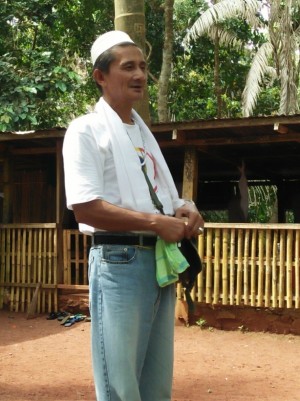The guardian of Tawi-Tawi’s Bud Bongao
Bud Bongao is a treasure trove of biodiversity and one of the last moist forests in the Sulu Archipelago.
It is among the landmarks of Tawi-Tawi and renowned as a sacred mountain by locals and visitors alike.
One of its local champions is 60-year old Rudy Hamja, whom everyone calls Imam Rudy.
Over the last three years, Imam Rudy has been regularly climbing Bud Bongao. He hikes up the mountain every day except Friday, ascending for 30 minutes and descending in as little as 15 minutes – twice as fast as a regular pilgrim!
All this climbing has kept Imam Rudy physically fit, making him look much younger than his real age. Daily trekking has made him fit — but for him, the trek up is a religious calling.
Imam Rudy reverently cleans the mountain’s Tampat or shrines. At the peak, he prepared a shaded area made out of bamboo and a bench made from coconut stalks.
Article continues after this advertisement
Rudy Hamja, guardian of Tawi-Tawi’s sacred mountain Bud Bongao. Photo contributed by WWF-Philippines.
“I want pilgrims to have a nice place to rest after climbing Bud Bongao,” he shares. He also created a small prayer room for those who wish to pray.
Article continues after this advertisementNot forgetting the famous monkeys of Bud Bongao, Imam Rudy planted fruit-bearing trees to someday feed them too. He has spent his own time and money to make this happen.
“I am doing all of this for a cause. As long as I can manage to climb Bud Bongao, I will do it with all my heart. I’m not earning from this, but I believe that the souls of our ancestors are there, watching over us,” he says.
“They continuously give me the strength and courage to do all I can to preserve Bud Bongao for tomorrow’s pilgrims. Someday, I want to look after them too, when my soul resides here.”
Over the years, Bud Bongao’s forest cover has been fast declining. Because of this, a noticeable number of Philippine Monkeys (Macaca fascicularis) are seen less frequently. These monkeys are considered nearly threatened according to the IUCN (International Union for Conservation of Nature).
A large populace of monkeys (including a famous white monkey) used to inhabit the mountain, but destructive activities around Bud Bongao — such as the cutting of trees, the clearing of land for agriculture and the irresponsibility of some residents along the area when disposing of trash — have been linked to their decline.
WWF-Philippines and the Philippine Tropical Forest Conservation Foundation, together with the local Bud Bongao Management Council seeks to change and regulate such activities that alter the biodiversity of the mountain.
The organizations plan to enhance local management capacity and streamline information, education and communication for the communities.
Hopefully, in time, more people will follow Imam Rudy’s lead and continue protecting the mountain. KS/rga
Gregg Yan is an environmentalist and the communications and media manager of WWF-Philippines.